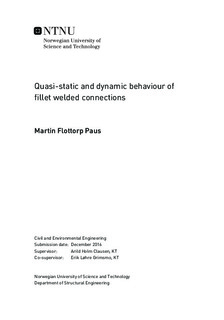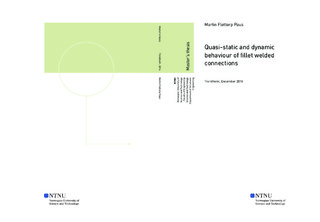| dc.contributor.advisor | Clausen, Arild Holm | |
| dc.contributor.advisor | Grimsmo, Erik Løhre | |
| dc.contributor.author | Paus, Martin Flottorp | |
| dc.date.accessioned | 2019-09-11T08:34:22Z | |
| dc.date.created | 2016-12-20 | |
| dc.date.issued | 2016 | |
| dc.identifier | ntnudaim:16079 | |
| dc.identifier.uri | http://hdl.handle.net/11250/2614866 | |
| dc.description.abstract | Introduction
Understanding the behaviour of the joints in a construction is crucial for structural engineers. In fact, the behaviour of steel joints exposed to static loading is well documented. Steel joints exposed to impact loading have received limited attention in the literature. In recent years, however, the interest in steel structures and joints under extreme conditions has grown. The main purposes of this master thesis were to
observe experimentally how fillet welded joints respond to impact and compare it to their response to quasi-static loading.
carry out material test and determine the material properties of the weld and base materials.
create representative numerical models and carry out final element simulations and compare the experimental results with the results from numerical simulations and Eurocode calculations.
Method
Two different component test specimen types were created, one with transverse and one with longitudinal fillet welds. Each specimen type was tested with both impact and quasi-static loading. DIC was employed to measure the deformations of the welds. The applied load was registered using strain gauges. Load and displacement curves were presented as the results for all the component tests.
Material test specimens were machined from an unused test specimen. The material test specimens were tested in tension at three different loading rates. The extracted properties were determined and inserted into the numerical models. Creating representative numerical 3D models of the component test specimens, and carrying out final element simulations of those models, have been significant parts of the work for this thesis.
Results and discussion
The component tests with transverse fillet welds showed higher strength and less deformation capacity than the component tests with longitudinal fillet welds. There were no significant differences in the strength of the component tests measured at impact and at quasi-static loading. The numerical simulations gave good compliance to the experimental results. However, the strengths in the numerical models, particularly for the quasi-static simulations, were somewhat reduced with respect to the experimental results. The results do not indicate that the resistance formulas in the Eurocode should be altered. | en |
| dc.language | eng | |
| dc.publisher | NTNU | |
| dc.subject | Bygg- og miljøteknikk, Beregningsmekanikk | en |
| dc.title | Quasi-static and dynamic behaviour of fillet welded connections | en |
| dc.type | Master thesis | en |
| dc.source.pagenumber | 96 | |
| dc.contributor.department | Norges teknisk-naturvitenskapelige universitet, Fakultet for ingeniørvitenskap,Institutt for konstruksjonsteknikk | nb_NO |
| dc.date.embargoenddate | 2019-12-20 | |

